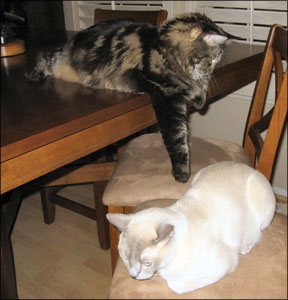Several years ago, my cat and I moved in with my grandmother, relieving some financial stress for me and allowing my grandmother to remain independent as her health declined. Her house was filled with beautiful antique furniture, and because I didnt think I had any other option, I had my cat declawed. She has adjusted to life without all ten of her third phalanges, but I

Bev Caldwell
288
wish that I had been better informed about other techniques available to discourage destructive scratching behavior. Not only are there easily implemented techniques that can help redirect the scratching instinct, but there are also fabrics and furniture designs that have little “cat appeal.”
“Regularly trimming nails is very helpful for limiting damage to furniture, ” says ELise Christensen, DVM, a board-certified veterinary behaviorist at NYC Veterinary Specialists in Manhattan. In addition to keeping your cats nails trimmed, it is important to establish approved scratching areas within your home. Dr. Christensen suggests initially using catnip and/or treats to attract your cat to approved scratching areas, and to be sure to reward desired behavior: “If you see the cat using the scratching post, reward with verbal praise, scratching or treats.” (And remember that rewards are in the eye of the cat – not the human!)
Similarly, she advises, “If you see the cat scratching in an inappropriate area, startle and redirect,” by calling the cat over to the scratching post or picking him up, nicely, setting him down by the scratching post, and rewarding scratching. There are also several deterrents available for special pieces of furniture. One example is Sticky Paws, strips with adhesive on both sides that you stick on your furniture. Cats hate the feel of the adhesive on their paws and will subsequently avoid scratching anywhere you use them. Another option is Soft Paws: These are lightweight vinyl caps for the cats nails that can last for four to six weeks. They are available in clear or colored plastic (see sidebar on next page). Additionally, there are spray-on deterrents available that wont harm your furniture.
It can also help immensely to begin with furniture that doesnt have a lot of “cat-appeal.” Peter Grigorov, co-owner of Contemporary Trends, a modern furniture store in Ithaca, New York, relates, “Over the years, weve had many customers searching for “cat-friendly” furniture. Weve also had lots of feedback from people with cats. The only constant seems to be that [what works] is up to the individual cat. My own cats ignore both fabric and leather but will happily shred wooden legs and door frames. In general,” says Mr. Grigorov, “we recommend smooth, tough fabrics like microfibers, leather and limited wood exposure … but make no promises about anything being catproof.”
Whether youre trying to protect antique furniture or simply redecorate your home, there are several ways to make your furniture less appealing to your cat and to make your cat less destructive, as well. With a little behavior modification – on both your part and your cats – you can have nice furniture that remains intact! (See related article in CatWatch, June 2008).



